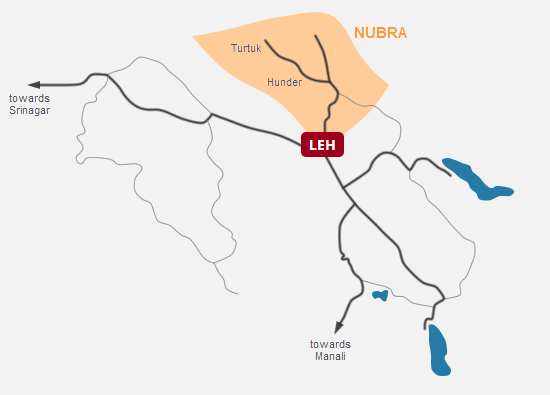

The Nubra valley tour starts with crossing the Khardung La pass, the world’s highest motorable road at an altitude of 5,602 metres above sea level. Khardung La pass connects Leh to the Nubra valley and it is strategically important to the Indian military force to carry supplies to the soldiers posted at the Siachen glacier near the India-Pakistan border.
The Nubra valley itself lies at an altitude of 3,150 metres above sea level (it is lower than Leh). Diskit monastery is the largest gompa in the valley, it was built in the fifteenth century on the side of rocky hill. It offers a spectacular view on the valley. A gigantic 32-metre-tall statue of Maitreya Buddha is located a few hundred meters away from the monastery.
Ten kilometres after Diskit, you can enjoy a double-humped Bactrian camel ride at Hunder sand dunes. With one extra day, you could drive all the way to Turtuk, a beautiful and peaceful Muslim village located just 12 kilometres from the Pakistan border.
Go and relax in Panamik village which is well known for its sulphur hot spring that is believed to have medicinal virtues. Hike to the picturesque Yarab Tso lake and visit Samstanling monastery in Sumur before heading back to Leh.
You can choose if you want to include Turtuk village and Panamik hot spring in your tour to Nubra valley:

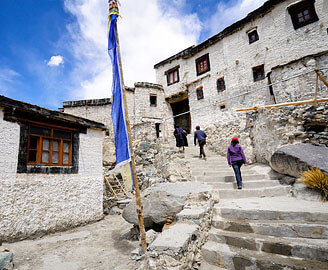
Nubra valley is situated to the north of Leh, crossing over Khardung La pass, the highest motorable road in the world. The name of the valley originated from the word Ldumra, which, in Ladakhi language, means an orchard or a garden. Aptly so, Ldumra does justice in defining the lush green valley full of gardens and orchards, nestled in the high snow-clad mountains.
The villages of Nubra valley are situated at the banks of Shayok River that originates from the Karakoram Mountains and merges into Indus River. The other important river of the valley is Siachen, which derives its name from the Siachen glacier. These rivers drain the whole expanse of Nubra.
Apart from the breathtaking natural beauty of its high ice-peaks, desert plains, forests and rivers, Nubra has a lot more to offer. Alike other regions of Ladakh, Buddhist monasteries of Nubra have their own interesting history and legends of origin. The intricate thankas, paintings, rock carvings and the annual monastic festivals are the main attraction for the tourists. If you are of adventurous type, you could try white-water rafting and kayaking in the thrilling Shayok River.
Let’s dig a little about Nubra and its varied attractions.
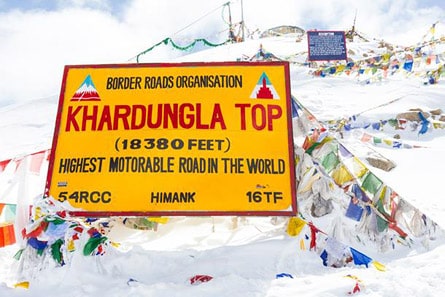
While touring towards the North-East of Leh, your vehicle will cross a high mountain pass. Congratulations! You rode the highest motorable road in the world with its ultimate point Khardung La pass at 5,602 meters above sea level. Descending the pass, the first Nubra village you will reach is Khardung village with a handful of households. As recent as 2008, Khardung La route was the sole access to Nubra. However, later, an alternative road was built via Wari La pass of Sakti village.
Being the highest point of the trip, Khardung La has become an unmissable attraction for the tourists. They make sure to alight here and stay awhile feeling the altitude, chilly wind and the panoramic expanse of Leh beneath. Needless to say, the spot turns into a memorabilia for the visitors. They click pictures and videos of the breathtaking backdrop of lit blue sky, high ice peaks and colourful strings of prayer flags.
Wait a minute. What about medical support at such a high altitude? Don’t worry. You could find a dispensary, in case of a need for urgent medical attention. A few small eateries also make your journey comfortable, providing tea and snacks to replenish your spirit.
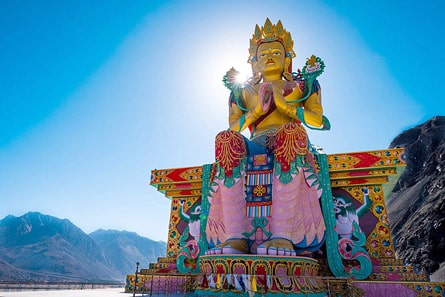
Diskit village is the administrative headquarter of Nubra valley. It hosts the oldest and largest monastery in the whole valley. Diskit monastery was founded by renowned Lama Jangsem Sherab Zangpo, one of the prominent disciples of Je Tsong Khapa, the founder of Gelugpa school of Buddhism, in the 14th century. The grand structure sits on top of a hill, providing a magnificent view of the valley with the serpentine Shayok River flowing leisurely through the plains.
The massive 32-meter high statue of Gyalwang Chamba (Maitreya Buddha) is the landmark of Nubra valley. The monastery has a clean and comfortable guest house at a reasonable rate. You could spend a night in the monastery, and catch up with the Morning Prayer session of monks and meditate in the main temple. The magnificent monastery, a sprawling market and the hub of office complexes make the place busiest of the valley.
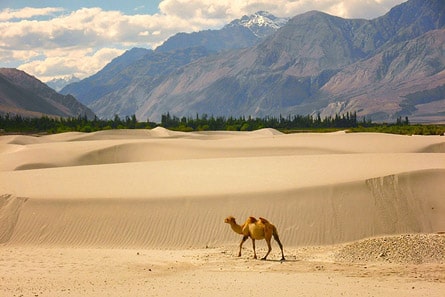
Nine kilometres west of Diskit is Hunder village, believed to be the first settlement of Nubra valley. Fertile land and easy access to water bodies made Hunder suitable for large habitation. Even historically, the village played an important role. In the 17th century, the village served as the capital of Nubra Kingdom. Due to its links to the kings and rulers, Hunder assumes an imposing historical seat too. The ruins at the top of a village hill are believed to be remains of the royal palace. The legend has it that the widowed queen of Nubra returned to Hunder Palace to spend the remainder of her life after the king’s demise.
Hunder sand dunes, formed after a historical flood in 1927, stretches several kilometres. Today, these formations mesmerize the visitors. In turn, the villagers have benefited from the economic activities around tourism. You can relish an evening on these dunes while enjoying folk dance and music.
Of the trade stock, Ladakh majorly engaged with Yarkand (Xinjiang, in today’s China). Nubra still has imprints and influence of the Yarkand culture and religion to this day. You can witness one such remnant in double-humped Bactrian Camels. The famed beasts were employed by the traders. They were mainly found in Yarkand. After the closing of the trade route due to political reasons, some of them remained in Nubra. Today, the people of Nubra have raised many batteries of Bactrian Camels for your amusement. In fact, you can hop on one and take a feel of the historical trader’s journey on the sand dunes of Hunder Village, passing around the sulphurous hot springs, fresh lakes and expenses of the green oasis, all but in a single ride! Isn’t it once in a lifetime experience?
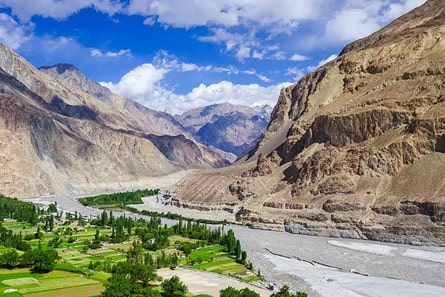
Turtuk village is known not only for its scenic beauty but also for the reason that it shares a border with Pakistan. Considered the northernmost point of India, it’s the only border area in Ladakh accessible for the tourists. The village has an interesting history. Turtuk, along with its three villages Tyakshi, Chalunkha and Dhothang, was once a part of Baltistan in Pakistan Occupied Kashmir. However, in the 1971 war between India and Pakistan, Turtuk was brought under India.
When you take a trip to the village, do lend a keen pair of ears to the locals. They will recount heartbreaking stories of the night when their elders slept in Pakistan but woke up in India the next morning. Many families, relatives and friends found themselves separated apart in two antagonistic countries forever. If you carry binoculars or with luck, sometimes the army post lends one, you could gaze at the Pakistani side of the border. And, maybe, have a peek at the villagers on the other side. Who knows?
Due to this peculiar past, Turtuk offers a distinctive Balti culture to witness. From their dresses to their cuisine, it’s a unique village not just in Nubra valley but in Ladakh as well. The inhabitants speak Balti language, a tongue mainly spoken in Baltistan today.
Due to its lower altitude, if toured at the right time of the season, you might get treated with luscious and sweet apricots that are famed across Ladakh. Only a few gompas dot the village, while a royal house is still preserved and maintained by the locals. You could also visit a Balti heritage museum, ruins of a Brokpa fort (the first settlers of Ladakh), a 16th-century old Mosque and many such curious attractions.

The literal name of Sumur village is Sum-yur, which translates as ‘three streams’. Situated along the Nubra River, with wide expanses of green fields and dense orchards, the village boasts of Samstanling monastery. Built in 1847, Samstanling is one of the largest gompas of Nubra with almost a hundred monk residents today. If you wish to stay in a peaceful place, Sumur could be the right choice. In the vicinity, you could also enjoy the waterfalls that dot the village. Since 2006, the villagers have begun offering accommodation facilities to the visitors for night stays. You could spend time at homestays, guesthouses and tent camps savouring the hospitality and stories of the families.
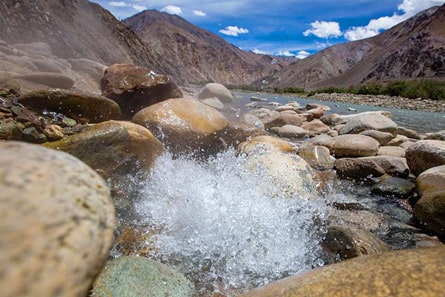
Panamik is a contraction of ‘Spang na Chumik’, meaning ‘the spring in the meadows’. A hot water-spring flows through the village meadows, hence the name Panamik or Spang na Chumik. The village is famed for its hot spring, considered therapeutic with medicinal benefits. The amchis (traditional doctors) recommend bathing in this hot spring to cure many ailments with high success rates.
Panamik is also the base camp for the trek to Ensa gompa. Hidden in the recess folds of mountains, Ensa monastery rests on a hill overlooking the valley beneath. Locals visit the gompa as a pilgrimage and to see the footprint of Maitreya Buddha, believed to be self-generated without anyone engraving it. Curious fact: back in the Silk Route days, Panamik was the first place for the traders from Yarkand to halt over. In fact, Nubra valley was the gateway to the Central Asian countries during the Silk Route days. Historically, it was a thoroughfare, an important trade landmark and a meeting point for the caravans, travellers of Tibet, Mongolia, Middle East and Europe.
The enchanting beauty of Nubra is best explored in the months of May to October when the valley is adorned with green fields, lush meadows and orchids ripe with plum apricots and sweet apples. The wildflowers blossom during this season, covering large expanses of mountains and plateaus in a blanket of varied colours and fragrance. These months remain moderate and soothingly breezy as compared to the colder months of the year. In case you are game, you could also help out with the farming activities and family chores of your hosts. Don’t hesitate to ask them for an opportunity to experience village life real close!
However, in case, you are occupied during the above mentioned months, April is also a good time to explore Nubra. Due to its lower altitude than other regions of Ladakh, the place remains pleasant during the month. However, some of your days might turn out hot with harsh sun and nights freezing cold. It is always advisable carrying warmers to cope up with the fluctuating temperatures.
Nubra valley remains accessible even in the winter. Due to its strategic importance, the army keep Khardung La open round the year. If you like to explore Nubra in winter, do keep two to three days of a buffer. In case of heavy snowfall, it takes some days for the pass to reopen. However, let us assure you, winter in Nubra is a surreal sight of snow-covered mountains and deserts that you would cherish for life.
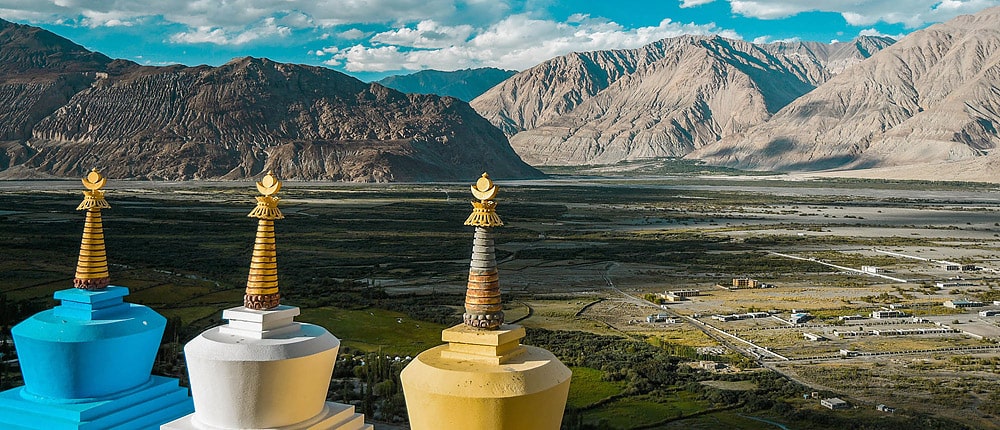
Nubra valley is at an average altitude of 3,150m, therefore it is lower than Leh. However, to reach Nubra, you need to drive across the Khardung La pass at 5,602m. Even though you will spend only a short time at this very high altitude, you still need to be well acclimatized before starting this trip. It is recommended to have 2 days of acclimatization in Leh and around before starting the Nubra valley tour.
Some of you might feel breathlessness, dizzy and heavy-headed while crossing the pass because of the lower oxygen concentration in the thin atmosphere. These are the first symptoms of Acute Mountain Sickness. Make sure you grab an oxygen cylinder on your excursions. Whenever the symptoms show up, take a couple of oxygen shots just to be on the safer side.
Dehydration is another issue. Due to dry air, many visitors get dehydrated real quick and quite often. Therefore, it is advisable to continuously drink lukewarm water, at least for the initial days of your trip. Carrying your own bottle of warm water could save you from many usual troubles like upset stomach, dry throat and dehydration.
Always carry your passport or a valid identification card. Nubra is a border area, therefore, a good basis of identification might come handy. Tourists (Indians and foreigners) will need an Inner Line Permit (known as Protected Area Permit for foreigners) while travelling to restricted areas like Nubra. This permit is also valid for other border areas such as Dha-Hanu and Pangong Lake. The permit can easily be arranged from Leh. Check this page for more information.
While touring Nubra valley, you will get BSNL reception at the base of Khardung La, at its top both Airtel and BSNL have services. In Diskit and Hunder, 2G Airtel and 3G/4G Jio networks work at a few spots. Finally, in Turtuk BSNL works but at a snail’s speed. For more information about mobile network coverage and internet access, check out this page.
In recent years, Nubra has emerged as the new tourism hotspot in Ladakh. Due to its stark landscape with razor-sharp peaks, huge sand dunes, thickets of shrubs and orchids of fruits and flowers, tourists make sure a tour of the region an integral part of their Ladakh itinerary. Consequently, many accommodation options (hotels, guesthouses and camps) have mushroomed across the valley, catering to every need of their clients.
Homestays can be found in every village of the Nubra valley and they offer the most authentic experience for a cheap price. Your driver will show you the best homestay options when you reach the place.
Stone Hedge Hotel, Lchang Nang Retreat and Chalet Seabuckthorn are some of the luxury hotels. Karma Inn, Hunder Sarai Resort and Hotel Stendel are some of the mid-range hotels, whereas, Olgok Guest House, Sand Dunes View Resort, Lotus Eco Resort and Namgyal Villa are some of the guesthouses that provide best of amenities and services.
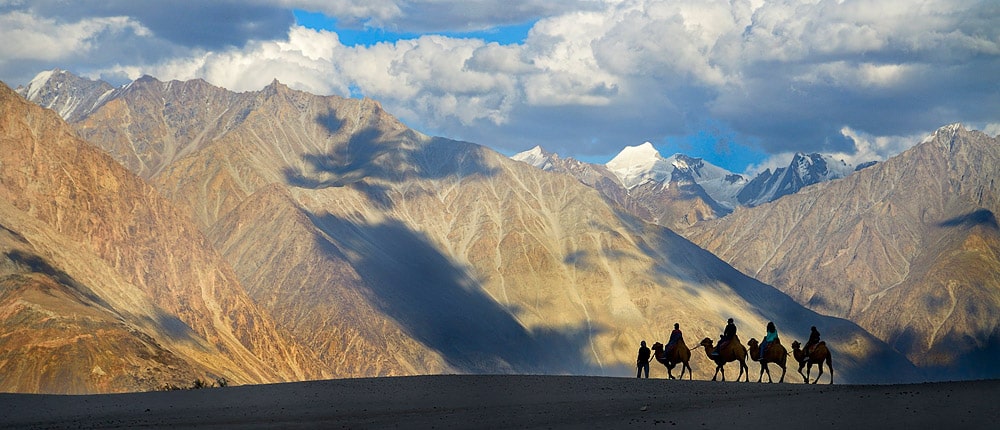
Drive from Leh to the Nubra valley via Khardung La pass. Visit Diskit monastery and Hunder sand dunes. Night in Hunder or Diskit.
Head to Sumur village and visit Samstanling monastery. Drive back to Leh.
From Leh, drive across the Khardung La pass to reach the Nubra valley. Visit Diskit monastery. Night in Diskit or Hunder.
Explore the Hunder sand dunes and experience a camel ride. Drive to Sumur village. Night in Sumur.
Take a stroll in Sumur village and visit Samstanling monastery. Drive back to Leh.
Drive from Leh to the Nubra valley via Khardung La pass. Visit Diskit monastery and Hunder sand dunes. Drive to Turtuk. Night in Turtuk.
Stroll around Turtuk village. Drive to Sumur and visit Samstanling monastery. Drive back to Leh.
Note: In 2 days, you will be able to spend only a small amount of time at each location. If you want more time for the visits, we recommend that you to do this tour in 3 days.
From Leh, head north to the Nubra valley via Khardung La pass. Visit Diskit monastery and Hunder sand dunes. Night in Hunder or Turtuk.
Explore Turtuk village. Drive back to Hunder. Night in Hunder, Diskit or Sumur.
Head to Sumur and visit Samstanling monastery. Drive back to Leh.
From Leh, drive across the Khardung La pass to reach the Nubra valley. Visit Diskit monastery and Hunder sand dunes. Night in Hunder, Diskit or Sumur.
Head to Panamik hot spring and stop at Yarab Tso lake. Drive back to Sumur and visit Samstanling monastery. Head back to Leh.
Drive from Leh to the Nubra valley via Khardung La pass. Visit Diskit monastery and Hunder sand dunes. Night in Hunder or Diskit.
Head to Yarab Tso lake that is reached after a 15-minute walk from the road. Drive to Panamik to see the hot spring. Night in Panamik or Sumur.
Stroll around Sumur village and visit Samstanling monastery. Drive back to Leh.
From Leh, drive across the Khardung La pass to reach the Nubra valley. Visit Diskit monastery and Hunder sand dunes. Night in Hunder or Turtuk.
Take a stroll in Turtuk village. Head towards Panamik and hike to Yarab Tso lake. Night in Sumur or Panamik.
Relax at the Panamik hot spring. Drive back to Sumur and visit Samstanling monastery. Head back to Leh.
From Leh, drive across the Khardung La pass to reach the Nubra valley. Visit Diskit monastery. Night in Diskit or Hunder.
Hike across the Hunder sand dunes and experience a camel ride. Drive to Turtuk and visit the village. Night in Turtuk.
Head to Panamik and its well-known hot spring. Near Panamik, walk to the hidden Yarab Tso lake. Night in Panamik or Sumur.
Take a stroll around Sumur village and visit Samstanling monastery. Drive back to Leh.
